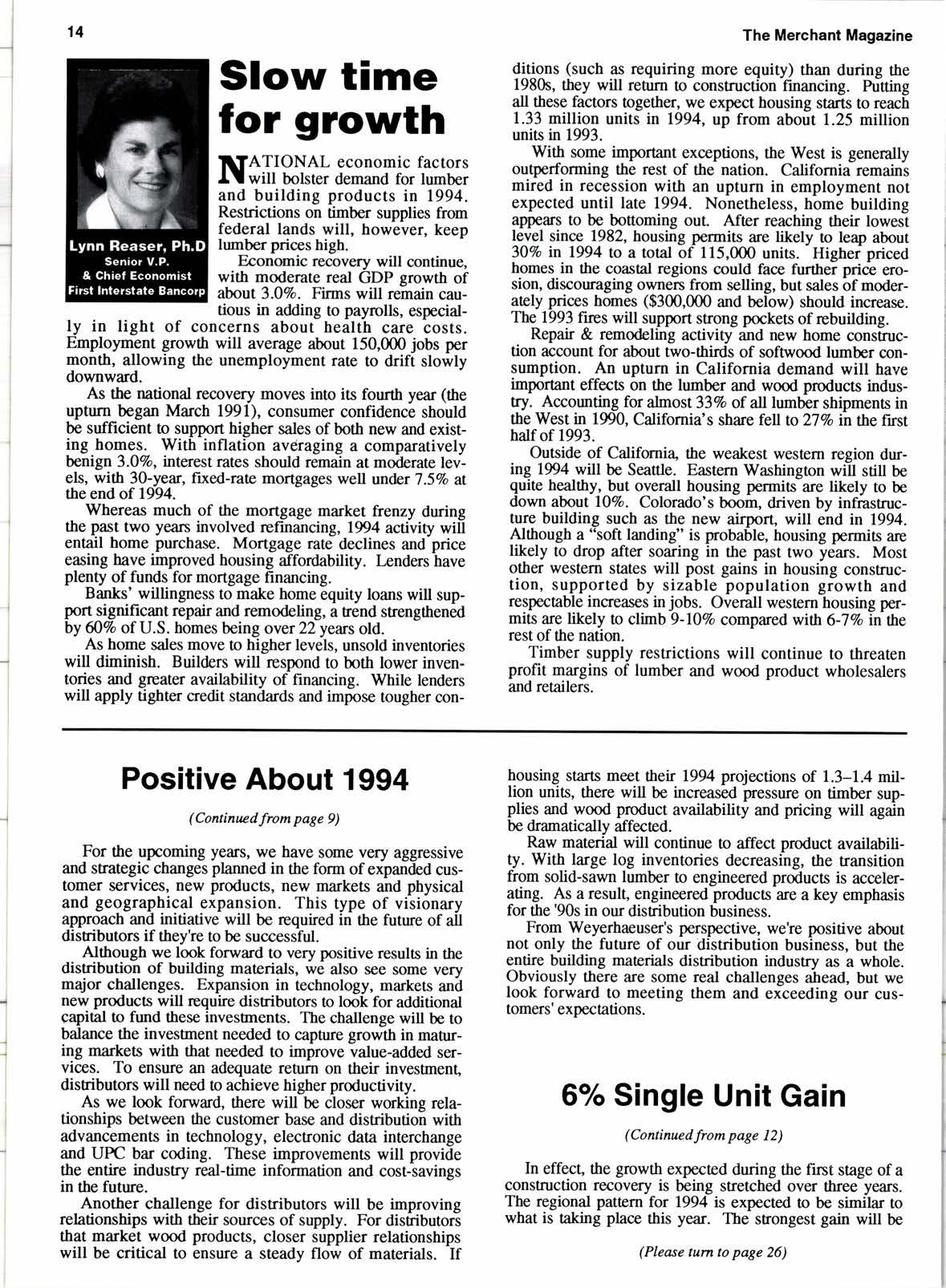
3 minute read
Slow time for growth
ATIONAL economic factors
Il will bolster demand for lumber and building products in 1994.
Restrictions on timber supplies from federal lands will, however, keep lumber prices high.
Econmric recovery will continue, with moderate real GDP growth of about 3.07o. Fimrs will remain cautious in adding to payrolls, especial- ly in light of concerns about health care costs. Employment growth will average about 150,000 jobs per month, allowing the unemployment rate to drift slowly downward.
As the national recovery moves into its fourth year (the upturn began March 1991), consumer confidence should be sufficient to support hrgher sales of both new and existing home-s- With inflation averaging a comparatively benign 3.07o, interest rates should remain at moderate levels, with 3O-year, fixed-rate mortgages well under 7,5Vo at the end of 1994.
Whereas much of the mortgage market ftenzy during the past two years involved refinancing, 1994 activity will entail home purchase. Mortgage rate declines and price easing have improved housing affordability. Irnders have plenty of funds for mortgage financing.
Banks' willingness to make home equity loans will support significant repair and remodeling, a Eend strengthened by 607o of U.S. homes being over 22 years old.
As home sales move o higher levels, unsold inventories will diminish. Builders will respond to both lower inventories and greate,r availability of financing. While lenders will apply tight€r credit standards and impose tougher con-
Positive About 1994
(Continrcdfrom page 9)
For the upcoming years, we have some very aggressive and sfarcgic changes planned in the fomr of expanded customer services, new products, new markets and physical and geographical expansion. This type of visionary approach and initiative will be required in the future of ail distributors if they re to be succ€ssful.
Although we look forward to very positive results in the distribution of buil4ng materials, we also see some very major challenges. Expansion in technology, markets and new products will require distributors to look for additional papital to fund these investurents. The challenge will be to balance the investment needed to captue growth in maturing narkets with that needed to improve value-added services. To ensure an adequate return on their investment, distributors will need to achieve higher productivity.
As we look forward, there will be closer working relationships between the customer base and distribution with advancenents in technology, electronic data interchange and UPC bar coding. These improvements will provide t[e entire industry real-time infonnation and cost-savings in the future.
A,nothgr challenge for distributors will be improving r"1"1i6nships with their sources of supply. For disdbutors that market wood products, closer supplier relationships will be critical to ensure a steady flow of materials. If ditions (such as requiring more equity) than during the 1980s, they will reuirn olonstruction'financing. p,ining all these factors together, we expoct housing starts to reach 1.33 million units in 1994, ap from abour 1.25 million units in 1993. housing starts meet their 1994 projections of 1.3-1.4 million units, there will be increased pressure on timber supplies and wood product availability and pricing will again be dramatically affected.
With some imporAnt exceptions, the West is generally outperfonning the rest of the nation. California remains mired in recession with an upturn in employment not expected until late 1994. Nonetheless, home building appgars to be botroming oul After reaching their lowest level since 1982, housing pennits are likely to leap about 30Vo in 1994 to a total of 115,000 units. -Highei priced homes in the coasal regions could face further price erosion, discouraging owners from selling, but sales of moderately prices homes ($300,000 and below) should increase. The 1993 fires will support strong pockets of rebuilding.
Repair & remodeling activity and new home construction account for about two-thirds of softwood lumber consumption. An upturn in California demand will have important effects on the lumber and wood products industry. Accouting for almost 33Vo of all lumber shipments in the West in 190, California's share fell to 27 Eo in the frst halfof 1993.
Outside of Californi4 the weakest westem region during 19,4 will be Seacle. Eastern Washington will still be quite healthy, -but overall housing permits are likely to be down about 10%. Colorado's boom, driven by infrastructure building such as the new airpo4 will end in 1994. Although a "soft landing" is probable, housing perrrits are likely to drop after soaring in the past two years. Most ottrer western states will post gains in housing construction, supported by sizable population grbwth and respoctable increases in jobs. Overall western housing permits are likely to clinb 9-107o compared with 6-7Vo ii the rest of the nation.
Timber supply restrictions will continue to threaten profit margins of lumber and wood product wholesalers and retailers.
Raw material will continue to affect product availability. With large log inventories decreasing, the transition from solid-sawn lumber to engineered products is accelerating. As a result, engineered products are a key emphasis for the'90s in our disribution business.
From Weyerhaeuser's perspective, we're positive about not only the future of our distribution business, but the erttire building naterials distribution industry as a whole. Obviously there are some real challenges ahead, but we look forward to meeting them and exceeding our customers' expectations.

